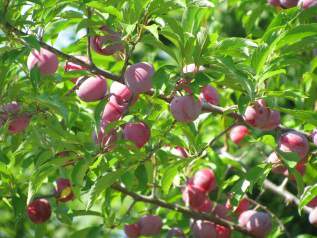Plums belong to the group of fruit trees known as ‘stone fruits’ and produce some of the most sweet and juicy fruit that we can grow in North Dakota. There are several varieties suitable for growing in northern areas.
Stone fruits also include sweet and tart cherries, peaches, Japanese and European plums, native plums, apricots and hybrids such as plucots or cherry plums. Of these, only native plums and their hybrids (except plucots) are reliably hardy and fruitful in our area. Some apricots are successful in protected areas or further south or west in the state, but fruiting is often affected by cold springs. Cherry plums are hardy crosses of native sand cherries and various plums. They have a very tart or astringent skin with sweet flesh and make a good jam.
Growing Plums: At CREC we selected four varieties of plums commonly available from nurseries and have added the American plum hybrid released by the USDA Plant Materials Center, Bismarck, ND. The varieties are: ‘Pembina’, ‘Pipestone’, ‘Toka’, ‘Waneta’ and ‘Prairie Red’. They have not had any winter damage that we can detect. They are covered in blooms each spring though fruiting seems to be more modest. We have not collected weights as they ripen intermittently, fall to the ground and are often eaten by squirrels. We have seen small areas of gummosis here and there and sunscald on one tree that had a green grow tube on the trunk in winter.

We selected the ‘open center’ method of training our plum trees. The varieties ‘Pembina’, ‘Pipestone’ and ‘Waneta’ grow with long branches (5-6 feet) that do not have many side shoots. When we have tip pruned them to encourage lateral growth, they have just extended the length of the branch from the next viable bud. Therefore, their structure is very open and vase shaped. Only ‘Toka’ grows in a well-branched manner, though ‘Prairie Red’ is too young to be able to determine its growth habit. ‘Toka’ is trained in more of a ‘modified leader’ method.
The fruit from the plum trees is good and sweet, though the skin is still slightly tart. Most of the fruit weighs about one ounce. ‘Pembina’ and ‘Pipestone’ ripen at nearly the same time and taste nearly the same. ‘Waneta’ ripens a week later and has a slightly better, ‘plummier’, flavor. ‘Toka’ ripens last and is the most delicious – but is also the smallest; the fruits are about 1-inch diameter.
<= Juneberry Top Red and White Currant =>